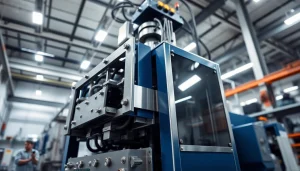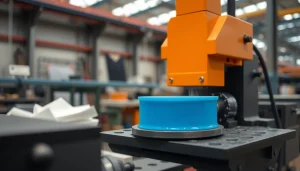Precision Die Cutting: Enhance Your Production with Custom Solutions
Understanding Precision Die Cutting
What is Precision Die Cutting?
Precision die cutting is an advanced manufacturing process that employs specialized equipment and tools to cut, shape, and mold various materials into specific forms with high accuracy. This technique is crucial in industries such as packaging, automotive, electronics, and medical devices, where exact specifications are paramount. Unlike traditional cutting methods, precision die cutting utilizes custom-made dies that ensure consistent quality and uniformity in manufacturing.
This process can handle various materials, including paper, cardboard, plastic, rubber, and metals, making it versatile and applicable across multiple industries. By employing precision die cutting, manufacturers can achieve intricate designs and complex geometries that would be challenging or impossible with other cutting methods.
Applications of Precision Die Cutting in Various Industries
The applications of precision die cutting are vast and diverse. Here are some of the key industries that benefit from this technology:
- Packaging: Precision die cutting plays a critical role in creating custom packaging solutions, such as boxes, inserts, and trays. Brands benefit from tailored designs that enhance product security and visual appeal.
- Automotive: In the automotive sector, precision die cutting is used to produce gaskets, seals, and insulation materials, ensuring components fit perfectly and maintain performance standards.
- Electronics: The electronics industry requires precise components for circuit boards, enclosures, and thermal management. Die cutting can produce intricate shapes that meet strict tolerances.
- Medical Devices: Precision is paramount in the medical field, where die cutting is utilized to fabricate parts for medical devices, packaging for sterile products, and even single-use items.
- Textiles and Fabrics: The fashion and upholstery industries utilize die cutting for intricate fabric shapes, allowing for complex designs in garments and furniture.
Benefits of Choosing Precision Die Cutting for Your Projects
Selecting precision die cutting for manufacturing projects offers numerous advantages that can streamline processes and improve product quality:
- High Accuracy: Custom dies can be engineered to achieve extremely tight tolerances, ensuring that parts are made to exact specifications every time.
- Cost-Effectiveness: For larger production runs, die cutting can be more cost-effective than alternative methods, as it minimizes waste and optimizes material usage.
- Faster Production Times: Precision die cutting is designed for high-speed production, allowing manufacturers to meet tight deadlines without compromising quality.
- Versatility: The ability to process various materials means that businesses can adapt to changing market demands without needing to invest in multiple production methods.
- Custom Solutions: Custom dies allow for unique designs tailored to specific applications, providing companies with a competitive edge.
Materials Used in Precision Die Cutting
Common Materials for Precision Die Cutting
Numerous materials can be effectively processed using precision die cutting, each having its unique properties and suitability for various applications. Some of the most commonly used materials include:
- Paper and Cardboard: Lightweight and easily printable, these materials are ideal for packaging and promotional items.
- Plastics: Different types of plastics, such as PET, polycarbonate, and polypropylene, can be die cut for consumer goods and industrial applications.
- Foam: Available in various densities and thicknesses, foam is extensively used for cushioning and insulation in packaging and automotive industries.
- Metals: Thin sheets of metals can be die cut to create components for machinery, electronics, and automotive parts.
- Rubber: Used for seals and gaskets, rubber die cutting is essential for the automotive and engineering sectors.
Choosing the Right Material for Your Die Cutting Needs
When selecting materials for precision die cutting projects, it is crucial to consider factors such as durability, flexibility, and the specific application requirements. For instance:
- Durability: If parts will be subjected to stress or will function as gaskets, opt for robust materials such as rubber or certain plastics.
- Precision Needs: For intricate shapes and details, thin materials like paper or soft plastics might be more appropriate.
- Cost Considerations: Evaluate the cost of materials and their processing; sometimes, a higher initial material cost can be justified by the performance benefits in the final product.
Impact of Material Selection on Production Costs
The choice of material not only affects the quality of the end product but also significantly influences production costs. Some key considerations include:
- Material Costs: Different materials come with varying price points. Understanding the market price can help in budget planning.
- Waste Levels: Choosing materials that optimize the cutting layout can reduce waste and lower overall costs.
- Processing Time: Some materials may require additional processing steps, which can lengthen lead times and increase labor costs.
Different Techniques of Precision Die Cutting
Flatbed vs Rotary Die Cutting Techniques
Both flatbed and rotary die cutting have unique characteristics that can influence the choice of process based on project requirements. Understanding these differences is vital for selecting the right method:
- Flatbed Die Cutting: In flatbed die cutting, the material is fed under a flat die that cuts the material in a punch-like action. This method is typically slower but offers high accuracy for thicker materials.
- Rotary Die Cutting: Rotary die cutting utilizes a cylindrical die that rotates continuously. This method is faster and is well-suited for mass production runs, especially with flexible materials like paper or plastic.
Laser Cutting: An Alternative to Traditional Methods
Laser cutting technology offers a different approach compared to traditional die cutting methods. Here’s an overview of its advantages:
- Precision: Lasers can achieve very fine cuts and intricate designs that might be challenging with dies.
- Material Versatility: Suitable for multiple materials, including acrylic, wood, and textiles.
- No Tooling Costs: Unlike die cutting, there is no need to invest in tooling, which can be cost-prohibitive for small runs.
Comparative Efficiency of Die Cutting Techniques
When comparing efficiency across die cutting techniques, several factors should be considered:
- Setup Time: Rotary die cutting generally has faster setup times for large runs compared to flatbed cutting.
- Material Waste: Efficient layout designs can significantly reduce waste in rotary die cutting, improving cost-effectiveness.
- Customization Flexibility: Laser cutting provides superior flexibility for changing designs without needing to create new tools.
Quality Control in Precision Die Cutting
Implementing Quality Standards in Die Cutting Processes
Ensuring high-quality output in precision die cutting involves implementing robust quality standards throughout production:
- Regular Equipment Maintenance: Ensuring that die-cutting machines and dies are maintained according to standards helps mitigate errors.
- Quality Inspections: Conducting routine inspections of finished products can identify defects early in the production cycle.
- Employee Training: Continuous training for machine operators on best practices enhances overall process performance and quality outcomes.
Tolerances and Allowances in Precision Die Cutting
Tolerances refer to the allowable variation in the dimensions of cut parts. In precision die cutting, maintaining strict tolerances is vital:
- Common Tolerance Ranges: For metal die cutting, tolerances typically fall within ±0.005 to ±0.015 inches depending on part complexity and material properties.
- Impact of Tolerance on Production Costs: Stricter tolerances may require more advanced die technologies and quality checks, influencing overall costs.
- Regulatory Standards: In certain industries like aerospace or medicine, adherence to stringent tolerances is legally mandated, affecting production processes.
Measuring the Success of Your Die Cutting Operations
To ensure continuous improvement, businesses should establish key performance indicators (KPIs) to gauge the success of their die cutting operations:
- Production Efficiency: Assessing overall equipment effectiveness (OEE) to identify potential bottlenecks.
- Waste Rates: Tracking scrap material helps minimize costs and improve environmental impact.
- Customer Satisfaction: Gathering feedback from clients about product quality and turnaround times can help refine processes.
Future Trends in Precision Die Cutting
Innovations Shaping the Precision Die Cutting Industry
As technology evolves, several key trends are emerging that will shape the future of precision die cutting:
- Advanced Automation: Automation technology is set to improve the speed and efficiency of die cutting processes, reducing labor costs and human error.
- Material Innovations: The introduction of advanced materials that are more durable, flexible, and environmentally friendly will further expand the applications of die cutting.
- Sustainable Practices: An increasing focus on sustainability is pushing manufacturers to adopt processes that reduce waste and energy consumption.
Automation and Technology Enhancements in Die Cutting
Technological advancements in automation are paving the way toward smarter manufacturing processes:
- Robotics: Incorporating robotics into die cutting operations can streamline material handling and increase production rates.
- IoT and Data Analytics: Leveraging Internet of Things (IoT) devices and data analytics can optimize machine performance and predict maintenance needs.
Preparing for the Future: What Businesses Need to Know
As the precision die cutting industry embraces change, companies should stay informed and adapt:
- Invest in Employee Training: Keeping staff knowledgeable about new technologies and processes is essential to maximizing efficiency.
- Embrace Technology: Businesses should invest in cutting-edge technology while evaluating their return on investment.
- Sustainability Goals: Aligning business objectives with sustainable practices can increase market competitiveness and customer loyalty.


